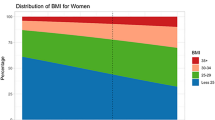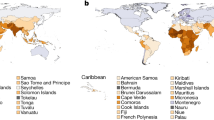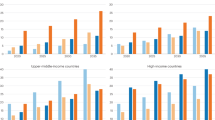Abstract
Objective:
To investigate the distribution of overweight and obesity and its relationship with socio-economic and behavioural factors in a developing-country population undergoing rapid nutritional transition.
Design:
Cross-sectional house-to-house survey in urban Gambia.
Subjects:
Four groups of 50 subjects were sampled as follows: young men (YM, 14–25 years), young women (YW, 14–25 years), older men (OM, 35–50 years) and older women (OW, 35–50 years).
Measurements:
Several socio-economic and behavioural factors were investigated. Composite indices for socio-economic status, education, healthy lifestyle and western influences were created. Body weight, height, waist and hip circumferences were measured and body mass index (BMI) was calculated. Body composition was assessed by leg-to-leg bioimpedance. Overweight was defined as BMI=25.0–29.9 kg/m2 and obesity as BMI⩾30.0 kg/m2.
Results:
There were highly significant gender and age differences in overweight (YM=0%, YW=10%, OM=6% and OW=34%) and obesity (YM=0%, YW=4%, OM=6% and OW=50%). Only 16% of OW were neither overweight nor obese compared to 88% of OM. OW had a higher fat mass percent (38.4%) than other groups, while fat-free mass (kg) was significantly higher in males than females with YW having the lowest value. Young generations were more educated and more influenced by western ideals than OM and OW. Weight gain was not always associated with weight concern and many overweight/obese subjects did not perceive themselves as overweight.
Conclusion:
Social and behavioural changes are already creating a perceptible ‘generational gap’ among this population undergoing rapid transition. The improved education and current lean status of the younger adults offers opportunities for preventative interventions. These need to be specially targeted at women.
This is a preview of subscription content, access via your institution
Access options
Subscribe to this journal
Receive 12 print issues and online access
$259.00 per year
only $21.58 per issue
Buy this article
- Purchase on Springer Link
- Instant access to full article PDF
Prices may be subject to local taxes which are calculated during checkout


Similar content being viewed by others
References
Anderson EYP (2004). A ‘coca-cola’ shape: cultural change, body image, and eating disorders in San Andres, Belize. Cult Med Psychiatry 28, 561–595.
Becker AE (2004). Television, disordered eating, and young women in Fiji: negotiating body image and identity during rapid social change. Cult Med Psychiatry 28, 533–559.
Becker AE, Burwell RA, Gilman SE, Herzog DB, Hamburg P (2002). Eating behaviour and attitudes following prolonged exposure to television among ethnic Fijian adolescent girls. Br J Psychiatry 180, 509–514.
Brown PJ, Konner M (1987). An anthropological perspective on obesity. Ann NY Acad Sci 499, 29–46.
Caldwell JC (2001). Population health in transition. Bull World Health Organ 79, 159–170.
Center of Disease Control (CDC) (2000). BMI growth charts 2–18 years. Atlanta, US.
Central Statistics Department (1996). Population and housing census of The Gambia, 1993. Banjul, The Gambia.
Cole TJ, Bellizzi MC, Flegal KM, Dietz WH (2000). Establishing a standard definition for child overweight and obesity worldwide: international survey. BMJ 320, 1–6.
Delpeuch F, Maire B (1997). Obesity and developing countries of the south. Med Trop 57, 380–388.
Deurenberg P, Yap M (1999). The assessment of obesity: methods for measuring body fat and global prevalence of obesity. Bailliere Clin Endocrinol Metab 13, 1–11.
Frankefield DC, Rowe DA, Cooney RN, Smith SJ, Becker D (2001). Limit of body mass index to detect obesity and predict body composition. Nutrition 17, 26–30.
Gunewardene A, Huon GF, Zheng R (2001). Exposure to westernization and dieting. A cross cultural study. Int J Eat Disord 29, 289–293.
Hill JO, Peters JC (1998). Environmental contributions to the obesity epidemic. Science 280, 1371–1374.
Holdsworth M, Gartner A, Landais E, Maire B, Delpeuch F (2004). Perceptions of healthy and desirable body size in urban Senegalese women. Int J Obesity Relat Metab Disord 28, 1561–1568.
Jebb SA, Cole TJ, Doman D, Murgatroyd PR, Prentice AM (2000). Evaluation of the novel Tanita body fat analyser to measure body fat by comparison with four-compartment model. Br J Nutr 83, 115–122.
Kumanyika S, Wilson JF, Guilford-Davemport M (1993). Weight related attitudes and behaviours of black women. J Am Diet Assoc 93, 416–422.
Lean ME, Han TS, Seidell JC (1998). Impairment of health and quality of life in people with large waist circumference. Lancet 351, 853–856.
Lean MEJ (2000). Pathophysiology of obesity. Proc Nutr Soc 59, 331–336.
Loveloy M (2001). Disturbances in the social body. Differences in body image and eating problems among African American and White Women. Gender Society 15, 239–261.
Martorell R, Khan KL, Hughes ML, Grummer-Strawn LH (2000). Obesity in women from developing countries. Eur J Clin Nutr 54, 247–252.
Nasser M, Katzman M, Gordon R (2001). Eating Disorders and Cultures in Transition. Hove: Brunner Routledge.
National Institute of Health (NIH) (1998). Bioelectrical impedance analysis in body composition measurement: national institute of health technology assessment conference statement. Am J Clin Nutr 64, 685–686.
Nunez C, Gallagher D, Visser M, Pi-Sunyer FX, Wang Z, Heymsfield SB (1997). Bioimpedance analysis: evaluation of leg-to-leg system based on pressure contact footpad electrodes. Med Sci Sports Exerc 29, 524–531.
Popkin BM (1999). Urbanization, lifestyle changes and the nutrition transition. World Dev 27, 1905–1916.
Popkin BM (2002). What is unique about the experience in lower and middle income less industrialised countries compared with the very high income industrialised countries? The shift in stages of the nutrition transition in the developing world differs from the past experience!. Public Health Nutr 5 (1A), 205–214.
Prentice AM, Jebb SA (2001). Beyond body mass index. Obesity Rev 2, 141–147.
Reddy KS (2002). Cardiovascular diseases in the developing countries: dimensions, determinants, dynamics and directions for public health actions. Public Health Nutr 5, 231–237.
Solomons NW, Gross R (1995). Urban nutrition in developing countries. Nutr Rev 53, 90–95.
Tsui EY, Gao XJ, Zinman B (1998). Bioelectrical impedance analysis (BIA) using bipolar foot electrodes in the assessment of body composition in Type 2 diabetes mellitus. Diabet Med 15, 125–128.
Utter AC, Nieman DC, Ward AN, Butterworth DE (1999). Use of the leg-to-leg bioelectrical impedance method in assessing body-composition change in obese women. Am J Clin Nutr 69, 603–607.
van der Sande MAB, Ceesay S, Milligam PJM, Nyan OA, Banya WAS, Prentice AM et al. (2001a). Obesity and undernutrition and cardiovascular risk. Factors in rural and urban Gambian communities. Am J Public Health 91, 1641–1644.
van der Sande MAB, Inskip HM, Jaiteh KO, Maine NP, Walraven GEL, Hall AJ et al. (2001b). Changing causes of death in the West African town of Banjul, 1942–1997. Bull WHO 79, 133–141.
Wagner DR, Heyward VH (2000). Measures of body composition in blacks and whites: a comparative review. Am J Clin Nutr 71, 1392–1402.
Walker ARP, Adam F, Walker B (2001). World pandemic of obesity: the situation in Southern African populations. Public Health 115, 368–372.
Walker ARP, Walker BF, Adam F (2002). Variations in occurrences of nutrition-related diseases in sub-Saharan Africans in stages of transition: what of the future? Nutrition 18, 71–74.
Wildes JE, Emery RE, Simons AD (2001). The roles of ethnicity and culture in the development of eating disturbance and body dissatisfaction: a meta analytic review. Clin Psychol Rev 21, 521–551.
Williamson L (1998). Eating disorders and the cultural forces behind the drive for thinness: are African American women really protected? Soc Work Health Care 28, 61–73.
World Health Organization (1998). Obesity: Preventing and managing the global epidemic. WHO/NUT/NCD/98.I.: Geneva, Switzerland.
World Health Organization (2004). World health report 2004: changing history. WHO: Geneva, Switzerland.
Acknowledgements
We are grateful to the fieldworkers Musu Bojang, Abdoulie Jatta and Omar Sanyang for their contribution to this project.
Author information
Authors and Affiliations
Corresponding author
Rights and permissions
About this article
Cite this article
Siervo, M., Grey, P., Nyan, O. et al. Urbanization and obesity in The Gambia: a country in the early stages of the demographic transition. Eur J Clin Nutr 60, 455–463 (2006). https://doi.org/10.1038/sj.ejcn.1602337
Received:
Revised:
Accepted:
Published:
Issue Date:
DOI: https://doi.org/10.1038/sj.ejcn.1602337
Keywords
This article is cited by
-
What is driving global obesity trends? Globalization or “modernization”?
Globalization and Health (2019)
-
Validation of Bioelectric Impedance Analysis against Dual-Energy X-ray Absorptiometry for assessment of body composition in Indian children aged 5 to 18 years
Indian Pediatrics (2017)
-
Stunting and weight statuses of adolescents differ between public and private schools in urban Gambia
International Journal of Public Health (2016)
-
Population-based survey of overweight and obesity and the associated factors in peri-urban and rural Eastern Uganda
BMC Public Health (2015)
-
Urbanization, nutrition and development in Southern African cities
Food Security (2014)



